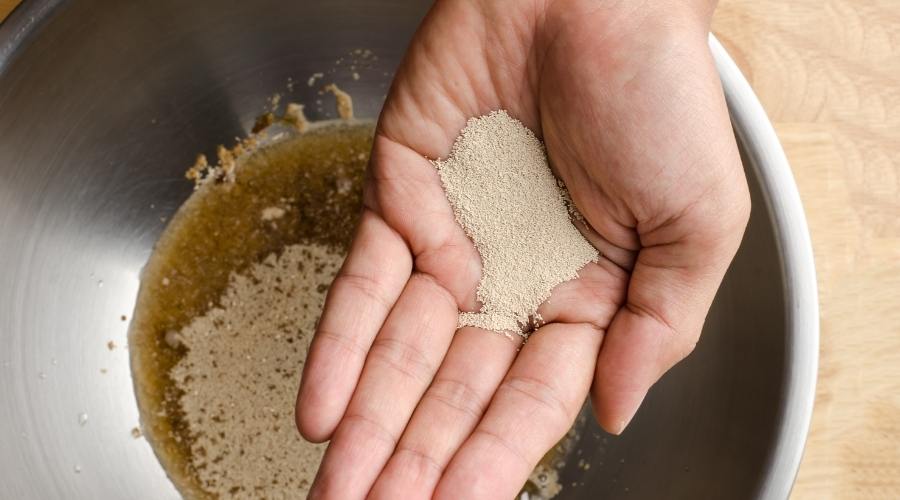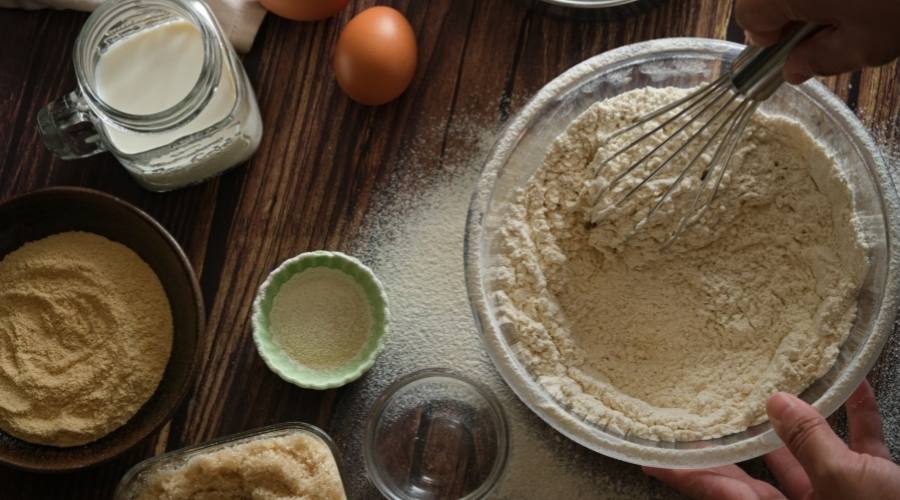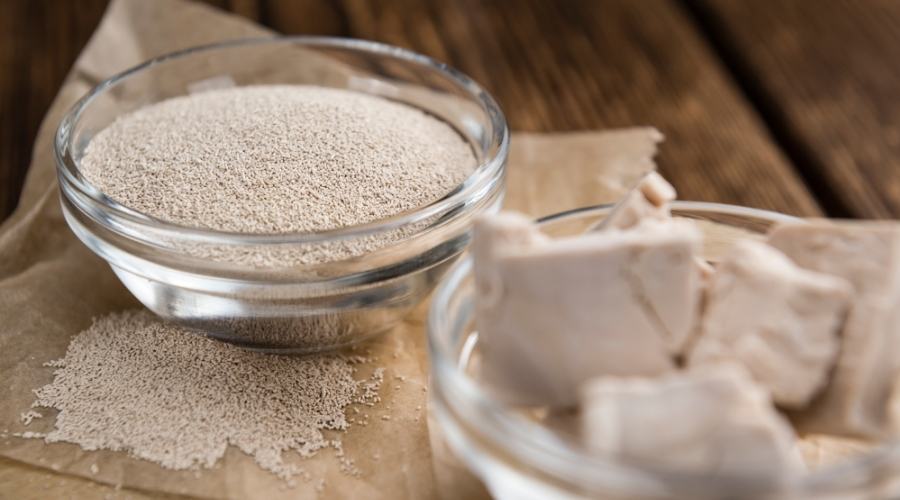One of my favorite things to do is make homemade bread. There’s just nothing better than warm bread and homemade strawberry jam. I always have bought and stored my own yeast so that I can make bread at any time.
During the summer months, I don’t usually make bread as often because I don’t want to heat up my house so my yeast sits for an extended period of time. I buy my yeast in bulk 1 pound packages because I use it fairly quickly and I don’t want to run out.
I have always stored my yeast long-term in the freezer in an airtight container because that’s what my mom did to extend its shelf life. One day as I pulled my yeast out to make bread I couldn’t help but wonder what is the actual shelf life of yeast and how should I be storing my yeast in bulk long term?
Hours of research confirmed many of the storage techniques that I was already following and also provided new insights that I will share with you below.
How To Store Yeast Long Term (in Bulk)
To store bulk Yeast long term it should be stored in a cool dry place such as a pantry or cold storage in its original packaging before being opened. Once the yeast has been opened its shelf life can be prolonged by being stored in a mason jar, mylar bag, or other air-tight container and kept in the refrigerator or freezer.
One of the most important elements in storing yeast long-term is to keep it free of moisture, heat, and oxygen. These three things can wake up the yeast which will cause them to die off quicker.
What to store Yeast in for the longest shelf life
- Mason Jars
- Sealed Mylar Bags
- Air-tight Containers
- Bucket with Gamma Lid
Where to store Yeast long term
- Cool Location (cold storage, pantry, basement, etc.)
- Refrigerator (fridge)
- Freezer
Yeast is a living organism, over time it will begin to lose activity even if the package has never been opened or you don’t use it regularly. When stored correctly you can get the longest shelf life out of your yeast.
Yeast can be left at room temperature for no longer than a month. However, you will see better results when stored in the refrigerator or freezer in an airtight container.
If you don’t bake often, buying the smaller packages of yeast might be a better option because they also come in much smaller amounts than the 1-2 pound bulk packages.
Packets of yeast can be stored in the cupboard or pantry with your other spices. It is not necessary for packets of yeast to be stored in the refrigerator or freezer.
Yeast is just one of many foods that you should store in your long-term food storage. See our Food Storage Calculator that will help you know exactly how much food you should store for yourself and your family and know what factors affect food life.
What Is The Shelf Life Of Yeast?
The shelf life of newly purchased unopened yeast is 1-2 years. You should try to use yeast by the best buy date to get the best reaction and rise in your bread. Once the yeast has expired the reaction will weaken and the rise will not be as good if there is any at all.
It is possible and very common for yeast to last months or even years beyond its best-by-date when stored properly. It is always a good idea to test the yeast in warm water before throwing it out. See how to test your Yeast below.
What Is The Shelf Life Of Yeast Once Opened?
Once yeast has been opened it should be used within 4 months. After 4 months the yeast starts to weaken, eventually becoming totally inactive and there will be no rise in your bread dough.
The good news is there are ways to extend the shelf life of your yeast

How to Extend The Shelf Life of Yeast
To get the longest shelf life possible keep your yeast free of moisture, heat, and oxygen by storing it in an airtight container and in the freezer. Storing yeast in the refrigerator can extend its shelf life for up to 4 months. Storing yeast in the freezer can extend its shelf life for up to 6 months.
3 Main Things to AVOID to get the Longest Shelf Life From Your Yeast
- Moisture – Store in a mason jar, sealed mylar bag, or other airtight containers
- Heat – keep in refrigerator, freezer, or at least in a cool location such as cold storage
- Oxygen – Sealed container with as much oxygen removed as possible
To get the longest shelf life out of your yeast the right storage conditions are going to be essential.
How Long Does Yeast Last In The Freezer?
Yeast will last up to 2 years in the freezer even after the original package has been opened. Yeast should be stored in an airtight container and kept away from moisture when stored in the freezer.
When yeast is stored in the freezer it can be pulled out of the freezer and used right away. There is no need to let it come to room temperature but you can bring it to room temperature if you would like.
It is best for yeast that has been stored in a refrigerator or freezer to have the amount needed measured out and put in warm water and immediately set aside to come to room temperature. Place the airtight container back in the refrigerator or freezer as quickly as possible to avoid condensation from building up compromising the remainder of your yeast.
Does Yeast Expire?
Yeast does have an expiration date which can be found on the manufacturer’s original packaging. Yeast is a living organism and will lose activity over time. However, don’t give up on your yeast even if the date has passed. Some yeasts will live past the expiration date and others will barely make it to that date.
To check if your yeast is still alive, put 2 ¼ tsp. in warm water (105*-115*F) with a pinch of sugar and let it sit for 5-10 minutes to see if it will bubble or foam. If it bubbles or foams it is still active and perfectly fine to use.
It is possible that yeast can last past the expiration date. However, yeast will generally not activate after 1 year past the expiration date.

How Do You Know If Yeast Has Expired?
You can tell if yeast has expired by putting the yeast in warm water and a pinch of sugar, covering it, then letting it sit for 5 to 10 minutes to see if the yeast will begin to bubble or foam. If there is no activity and the yeast has not started to bubble or foam the yeast is expired and will do no good. If the yeast has started to bubble or foam you can proceed with using the yeast in your recipe. See the full test below.
**When testing for activity your water should be warm but no hotter than 140*F 60*C or it will kill the yeast.
Try a Yeast Freshness Test
Instead of throwing out expired Yeast perform a Yeast freshness test like the Red Star yeast test to see if your yeast is still active:
- Use a one-cup liquid measuring cup and dissolve 1 teaspoon of granulated sugar in ½ cup of warm tap water at 110°-115° (If you don’t have a way to take the temperature, use tap water that is warm, but not hot to the touch).
- Stir in one ¼ oz. packet (7g) or 2 ¼ teaspoons of dry yeast until it is dissolved. Make sure that the Yeast is at room temperature before using.
- In 3-4 minutes, the yeast will have absorbed enough liquid to activate and start to rise.
- After 10 minutes, the foamy yeast mixture should have risen to the 1-cup mark and have a rounded top.
- If this happens, your yeast is very active and should be used in your recipe immediately.
- Remember to deduct ½ cup of liquid from the recipe to adjust for the water used in this test.
- If the yeast did not rise to the 1-cup mark, your yeast has little or no activity. Discard this yeast.
Is It Ok To Use Expired Yeast?
If the yeast is still active it is safe to use after it has expired. Expired yeast generally means that it is past when the yeast would be active and it will no longer reactivate to raise your dough. If the yeast has expired meaning it does not bubble or foam when put in warm water for 5-10 minutes there is no use in using the yeast in your recipe.
What is the difference between active dry yeast and instant yeast?
Active dry yeast needs to be activated prior to putting it in a recipe while instant yeast is ready to go as soon as it comes out of the package and can go right into a recipe.
You can use active dry yeast and active yeast interchangeably. Active dry yeast will just need to be activated in warm liquid before it is put with the other ingredients. When using active dry yeast in place of instant yeast the rise time will be a little longer as well.
Summary
Yeast is easy to store in an airtight container and has an extended shelf life of up to 2 years when stored correctly. Yeast along with other staple items such as flour, rice, and sugar is something that should be kept on hand for emergency situations however it is not something that can be stored for a super long term because it is a living organism that over time loses its activity causing your bread not to rise.
If you want to have yeast on hand you can buy it in bulk, 1 pound packages, 4oz. jars, or smaller packets containing 3 packets of 2 ¼ tsp. each.
Yeast can last well past its best-by-date when stored correctly and is safe to use if it is still active. To check if your yeast is still active you can put it in warm water and wait 5-10 minutes to see if it will bubble or foam. If it bubbles or foams it is still active and safe to use. If there is no activity the yeast is no longer active and will not raise your bread.


